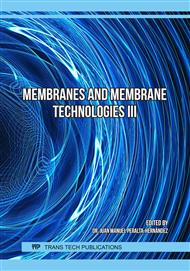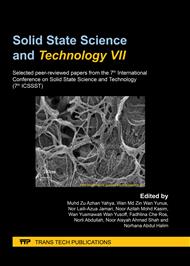[1]
D.H. Furukawa, Membrane Technologies for Water and Wastewater Treatment, TechCommentary. (1997) 1–6.
Google Scholar
[2]
H. Zhou, D.W. Smith, Advanced technologies in water and wastewater treatment, Journal of Environmental Engineering and Science 1(4) (2002) 247–264.
Google Scholar
[3]
M. Jahanshahi, A. Rahimpour, M. Peyravi, Developing thin film composite poly(piperazine-amide) and poly(vinyl-alcohol) nanofiltration membranes, Desalination 257(1-3) (2010) 129–136.
DOI: 10.1016/j.desal.2010.02.034
Google Scholar
[4]
N.H.H. Hairom, A.W. Mohammad, A.A.H. Kadhum, Journal of Water Process Engineering Nanofiltration of hazardous Congo red dye: Performance and flux decline analysis. Journal of Water Process Engineering 4 (2014) 99–106.
DOI: 10.1016/j.jwpe.2014.09.008
Google Scholar
[5]
J.M. Laine, D. Vial, P. Moulart, Status after 10 years of operation: Overview of UF technology today, Desalination 131 (2000) 17–25.
DOI: 10.1016/s0011-9164(00)90002-x
Google Scholar
[6]
Z. Teng, J. Yuan Huang, K. Fujita, S. Takizawa, Manganese removal by hollow fiber micro-filter. Membrane separation for drinking water, Desalination 139(1-3) (2001) 411–418.
DOI: 10.1016/s0011-9164(01)00342-3
Google Scholar
[7]
H. Kim, J. Choi, S. Takizawa, Comparison of initial filtration resistance by pretreatment processes in the nanofiltration for drinking water treatment, Separation and Purification Technology 56(3) (2007) 354–362.
DOI: 10.1016/j.seppur.2007.02.016
Google Scholar
[8]
M. Belkacem, S. Bekhti, K. Bensadok, Groundwater treatment by reverse osmosis, Desalination 206(1-3) (2007) 100–106.
DOI: 10.1016/j.desal.2006.02.062
Google Scholar
[9]
J. Schaep, B. van Der Bruggen, S. Uytterhoeven, R. Croux, C. Vandecasteele, D. Wilms, E. van Houtte, Removal of hardness from groundwater by nanofiltration, Desalination 119 (1998) 295–302.
DOI: 10.1016/s0011-9164(98)00172-6
Google Scholar
[10]
N. Hilal, H. Al-Zoubi, N.A. Darwish, A.W. Mohammad, Characterisation of nanofiltration membranes using atomic force microscopy, Desalination 177(1-3) (2005) 187–199.
DOI: 10.1016/j.desal.2004.12.008
Google Scholar
[11]
A. Khalik, V.S. Praptowidodo, Nanofiltration for drinking water production from deep well water, Desalination 132 (2000) 287–292.
DOI: 10.1016/s0011-9164(00)00162-4
Google Scholar
[12]
A.W. Mohammad, R. Othman, N. Hilal, Potential use of nanofiltration membranes in treatment of industrial wastewater from Ni-P electroless plating, Desalination 168 (2004) 241–252.
DOI: 10.1016/j.desal.2004.07.004
Google Scholar
[13]
X. Shengji, L. Xing, Y. Ji, D. Bingzhi, Y. Juanjuan, Application of membrane techniques to produce drinking water in China, Desalination 222 (2008) 497–501.
DOI: 10.1016/j.desal.2007.01.142
Google Scholar
[14]
B. Van der Bruggen, C. Vandecasteele, Removal of pollutants from surface water and groundwater by nanofiltration: overview of possible applications in the drinking water industry, Environmental Pollution 122 (2003) 435–445.
DOI: 10.1016/s0269-7491(02)00308-1
Google Scholar
[15]
A. De Munari, A.I. Schäfer, Impact of speciation on removal of manganese and organic matter by nanofiltration, Journal of Water Supply: Research and Technology-AQUA 59(2-3) (2010) 152–163.
DOI: 10.2166/aqua.2010.067
Google Scholar
[16]
R. Molinari, P. Argurio, L. Romeo, Studies on interactions between membranes (RO and NF) and pollutants (SiO2, NO3−, Mn2+ and humic acid) in water, Desalination 138(1-3) (2001) 271–281.
DOI: 10.1016/s0011-9164(01)00273-9
Google Scholar
[17]
J.H. Potgieter, R.I. Mccrindle, Z. Sihlali, R. Schwarzer, N. Basson, Removal of Iron and Manganese from Water A High Organic Carbon Loading. Part I : The Effect of Various Coagulants, Water, Air and Soil Pollution 162 (2005) 49–59.
DOI: 10.1007/s11270-005-5992-x
Google Scholar
[18]
M. Liu, Z. Lü, Z. Chen, S. Yu, C. Gao, Comparison of reverse osmosis and nanofiltration membranes in the treatment of biologically treated textile effluent for water reuse, Desalination 281 (2011) 372–378.
DOI: 10.1016/j.desal.2011.08.023
Google Scholar
[19]
L.Y. Ng, C.P. Leo, A.W. Mohammad, Optimizing the Incorporation of Silica Nanoparticles in Polysulfone/Poly(vinyl alcohol) Membranes with Response Surface Methodology, Journal of applied polymer science 121(3) (2011) 1804–1814.
DOI: 10.1002/app.33628
Google Scholar
[20]
WHO. Guidelines for drinking-water quality. Recommendations, vol.1, 3rd Edition, World Health Organization, Geneva, 2008, p.390–399.
Google Scholar
[21]
Y. Mansourpanah, M. Samimi, Preparation and characterization of a low-pressure efficient polyamide multi-layer membrane for water treatment and dye removal, Journal of Industrial and Engineering Chemistry 53 (2017) 93-104.
DOI: 10.1016/j.jiec.2017.04.007
Google Scholar
[22]
S. Zulaikha, W.J. Lau, A.F. Ismail, J. Jaafar, Journal of Water Process Engineering Treatment of restaurant wastewater using ultrafiltration and nanofiltration membranes, Journal of Water Process Engineering 2 (2014) 58–62.
DOI: 10.1016/j.jwpe.2014.05.001
Google Scholar
[23]
H. Abdul Aziz, S.N. Mohd Shakr, N.A. Akbar, Y.D.A Motasem, The removal efficiency of iron and manganese from pre-ozonated groundwater using limestone filter, Water Quality Research Journal 55 (2) (2020) 167-183.
DOI: 10.2166/wqrj.2020.014
Google Scholar
[24]
B.A.M., Al-Rashdi, D.J. Johnson, N. Hilal, Removal of heavy metal ions by nanofiltration, Desalination 315 (2013)2–17.
DOI: 10.1016/j.desal.2012.05.022
Google Scholar
[25]
B. Tansel, Significance of thermodynamic and physical characteristics on permeation of ions during membrane separation: Hydrated radius, hydration free energy and viscous effects, Separation and Purification Technology 86 (2012) 119–126.
DOI: 10.1016/j.seppur.2011.10.033
Google Scholar
[26]
M. Haddad, T. Ohkame, P.R. Berube, B. Barbeau, Performance of thin-film composite hollow fiber nanofiltration for the removal of dissolved Mn, Fe and NOM from domestic groundwater supplies, Water Research Journal 145 (2018) 408-417.
DOI: 10.1016/j.watres.2018.08.032
Google Scholar



